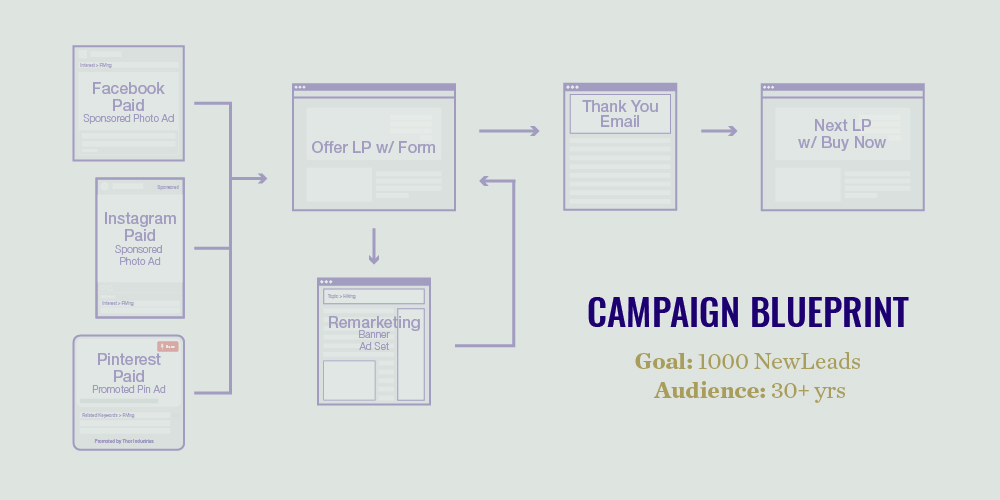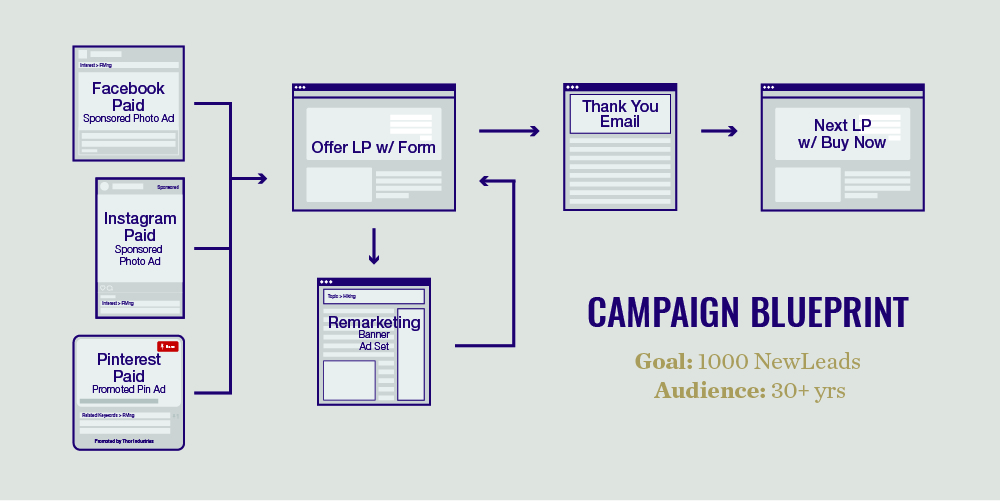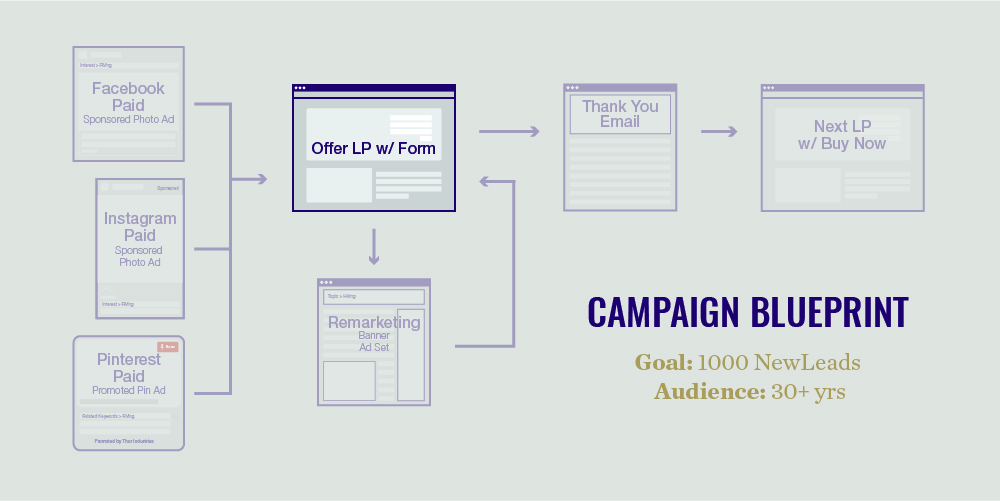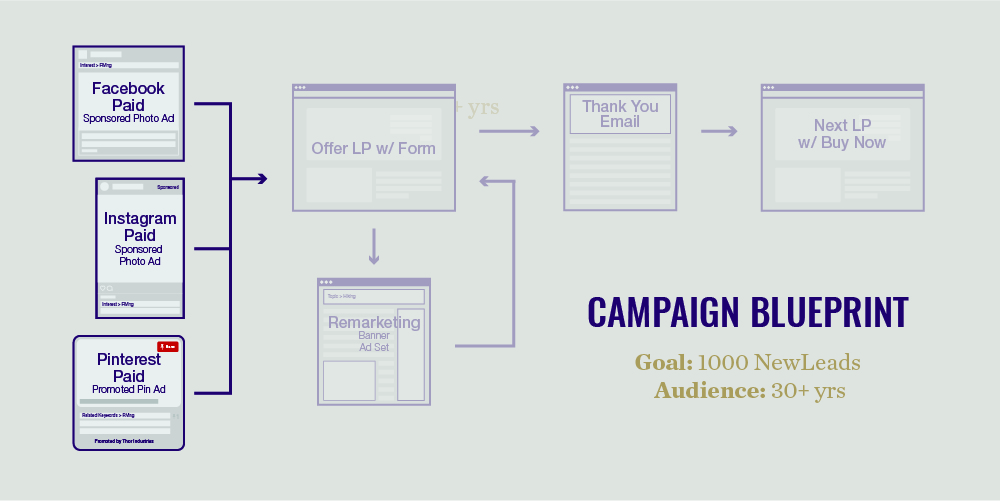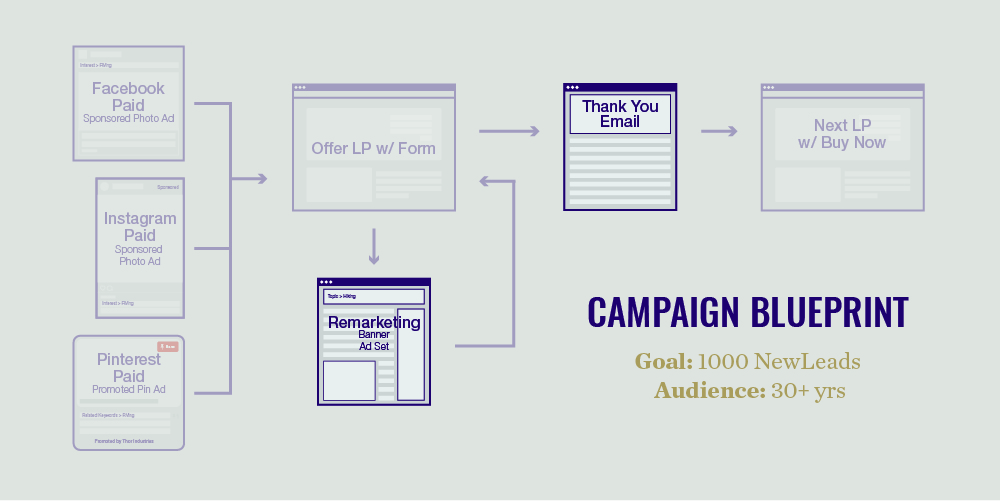The genesis is usually the same: “Let’s do a campaign to push a product/service/marketing goal.” Three weeks later, you’re asking, “Why are we doing this? What’s the purpose of this thing?” Confusion sets in, but deadlines being what they are, the team slogs on and gets “it” live. And a few more weeks later, the results aren’t what you forecasted or expected.
Sound familiar? If so, my friend, you need to learn the art of the marketing campaign blueprint. In this post, we’ll discuss why you need a campaign blueprint, what goes into one, who needs to be involved, and how to create and use blueprints moving forward.
What Is a Campaign Blueprint?
A campaign blueprint is a document that graphically lays out the elements of a marketing campaign, with some key details included, to help identify the purpose of each part of the overall campaign. This should include the overall strategic goals of the campaign, the purpose of each element within, and how each tactical element will help reach your goals.
It doesn’t take the place of a creative or project brief—in fact, it’s most likely the final outcome of the planning phase of a project, after review and approval of a brief or project proposal. And it doesn’t have to be limited to agency use. Internal teams can benefit from documenting their strategic plans as much as agencies, even if all of the personnel planning, executing, and reporting on the success of the campaign are in the same department.
The overriding purpose of the blueprint document is to provide clarity to all team members involved in planning and executing the campaign. By aligning the elements that emerge from concepting and planning meetings, you ensure that nothing is missed, and that each role can state what they need to do with each element in the campaign.
There’s one additional benefit—the blueprint also provides clarity to your key stakeholders who are greenlighting the project and may have questions about how much work is going into it, when things will be done, or what tactics will be used to reach the goal. When everything’s said and done, if your blueprint hasn’t provided clarity to your executors and stakeholders, it’s not ready yet. Let’s look at a process to ensure that gets done.
What’s the Purpose? What’s the Goal?
All too often, people lose sight of the goals of their marketing efforts. Good directors and managers try not to let this happen, but when the moving parts get to moving, or as campaigns become more complex, it still happens even to the best of us.
In the best of circumstances, every marketing campaign begins with a SMART goal—Specific, Measurable, Achievable, Relevant, and Time-bound. Yes, there are other uses of the acronym, but even they tend to lean back to these same principles, just using different words in different places.
A good rule of thumb when developing your projects, proposals, and briefs, where goals are concerned, is to make sure your goals all meet the following criteria:
- Will accomplishing this provide a clear business impact?
- Can we track success?
- Is the forecasted impact relevant to what’s important right now?
- Do we have the resources necessary to achieve this?
- Do we know the details necessary to make this a success?
- Are the scope, desired results, and requirements to get there clearly established?
- What’s the opportunity cost of doing this work, as opposed to something else?
You should know all of these answers before beginning your campaign blueprint. There is a lot of content out there about writing SMART goals, so there’s no need to repeat it all here. Just be sure you know the necessary details around your goals—the desired results and the means to get there.
Your campaign blueprint should clearly state the project goal upfront, and should likely include the purpose, desired or forecasted results, audience information, and timeline for the project. It should also include all of the following:
- The related project or service to market
- The audience to market to
- The budget for resource creation
- The budget for promotional efforts/media spend
- The timeline to achieve the goals
- The desired goals themselves
Campaign goals are clearly stated
The Strategic and the Tactical
Once you’ve stated the overall purpose and SMART goal for your campaign, you’ve laid the groundwork for the top strategic initiative for the campaign. Any questions related to “is this relevant” can and should be tracked back to the strategic purpose statement that sits atop your blueprint.
Take, for instance, a campaign whose purpose is to target a new demographic for an existing product in order to generate a specific amount of leads in two months. If someone were to suggest sending a promotional email to the entire email database, well… that’s not very targeted to the strategic purpose. If that tactic was narrowed to focus on a specific segment within the database that is based on the new demographic information and hasn’t purchased before, that’s in better alignment with the purpose.
You can quickly see how having the purpose and its parameters plainly stated can help those working on the campaign create a mini-flowchart in their head for creating ideas and materials for the campaign. “Does this match the strategic purpose of the campaign and help us meet the goals?” If yes, move ahead! If no, revamp your idea or try something else.
Mini-flowchart example
Fulcrums and Levers
Every campaign likely has a few big strategic initiatives, capture points, or areas of action that support the overall campaign—an offer, landing page, or other element on which the other elements of the campaign rest. We call these “Fulcrum” elements. They are directly related to the success metrics of the campaign—where you are sending traffic, impressions, people, etc. in order to achieve success—and thus are often conversion points. They are where actions take place that add to the campaign goals.
These larger Fulcrum elements likely take center stage on your campaign blueprint documents—prominently featured with details around how the work gets done and how elements are expected to perform.
Fulcrum elements example
Surrounding your Fulcrum elements will be small, tactically focused elements, initiatives designed to drive action towards the Fulcrum elements. Predictably, we can call these initiatives “Levers.” Levers help us get people to where we want them to go, so they can take the action that will add to our overall goals.
Initiatives—or levers—example
It’s important to keep these very tactical and simplified. For instance, ads should be broken down by channels, purpose, and offers. Emails should be separated by purpose, target audience, and the like. Be sure to detail how each Lever will contribute to the goals of the campaign, just like you did for the Fulcrums.
Once you’ve filled in your Fulcrums and Levers, there still may be something missing—initiatives that activate after an action, such as a thank you email for a form conversion or a retargeting ad for a landing page visit that didn’t end in a conversion. These elements can be called “Outcomes.”
Outcomes examples
Outcomes may lead to other initiatives, becoming Levers or leading to other Fulcrums. Depending on the depth and complexity of your campaign, these can add up. Initiatives such as lead nurturing workflows or complex remarketing campaigns that are multi-channel in nature may merit blueprints of their own. Not to worry—remember the purpose of the blueprint is to “provide clarity to all team members involved in planning and executing the campaign.”
If your campaign blueprint is actually a series of several diagrams and workflows, that’s okay. So long as everything is captured, passes the “does this match the strategic purpose of the campaign?” test, and is detailed accordingly, your blueprint can be as big or as simple as you need it to be.
Each Person Has a Job to Do
After you’ve detailed all your initiatives—your Levers, Fulcrums, and Outcomes—you’ll be ready to assign work to the appropriate executors. Depending on the nature of your team, there’s likely a lot to do and that work is spread throughout multiple roles.
Thankfully, now you’ve got a diagram you can use to show where copywriters need to write, graphic designers need to design, digital marketers need to target and automate, and developers need to program, along with any other work that needs to get done.
Your project manager likely has a path to success, now, too. But it’s missing one more critical aspect of the campaign: timing.
Timing
Your executors need time to get the job done. Your stakeholders need results. Balancing these two will help make your campaign a success—and you can note that within your blueprint.
When is the campaign going to launch? What Levers get activated when? When do workflows fire for lead nurturing? These operational questions are essential for answering how (and when) the campaign goals get achieved.
Likewise, your executors are going to need time to write copy, design ads and webpages, develop content, build retargeting audiences, and the like. The time it takes to do these things has an impact on overall campaign launch dates and when appropriate Levers can be pulled.
Noting the time needed to create the work and when the work needs to activate will help your project managers build a plan that gets things done at the right time. It also provides a real example of just where the gears are going to grind if a deadline is missed—what’s not going to be effective or fire correctly because an element is delayed or missing.
Timing can be everything in successfully completing a campaign. Capturing this within the blueprint creates meaning for others so they can see how their individual work contributes to the successes of the whole campaign. Some dates may be needed for internal purposes for project management only, but getting them all detailed out and in the plan will be immensely helpful.
Bringing It All Together
Finally, once you’ve got all your aspects outlined—your timing, your roles for execution, and all of the elements big and small that need to be executed on—you’ve got a document that you can provide to others that details the necessary factors to lead towards success.
You should be able to hold up a campaign brief next to your campaign goals, creative brief, project brief, stakeholders, and team of executors, with confidence that all of their questions are answered. Clarity is provided. There’s a plan, a goal, and everyone has a job to do to get us there.
Is a campaign blueprint going to solve all the world’s problems, or even just the marketing team’s? No. But it should provide a great deal of clarity to people involved in a marketing campaign.
Just like any blueprint, you’ve still got to actually build the thing, and then test whether it works. However, if you’ve done your homework right and you have trusted, capable people helping along the way, the blueprint should help make the chances of success that much higher. At worst, it should eliminate excuses about not knowing what was needed when, who was responsible, and why a thing was needed.
All the Details, All the Time
Campaign blueprints should help any marketing team find critical paths toward success in many endeavors, but they’re not the only element (besides the work) that’s going to drive success.
There’s still a dozen things that need to happen for a marketing campaign to succeed. Goals need to be validated. Creative needs time to concept to create the amazing ideas that are going to make the campaign meaningful to its target audience. Strategists need time to research how to provide valuable details to creatives for execution. Someone has to figure out how to track, measure, and report on all these initiatives.
And no plan ever survived contact with the enemy… er, audience.
Even with the best of blueprints, things will happen during a campaign that will necessitate changes. Goals get updated, budgets get cut, the list goes on and on. But knowing where everything is in the process of execution will help make the process of assimilating those changes all the easier. And knowing is half the battle, after all.
Try your hand at creating your own plan. Or relax, give us a call, and let us know what big marketing initiative needs some love on your end, and let us plan the battle that leads to victory for you.



